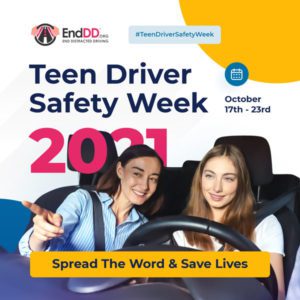How to Protect Teen Drivers and Make Roads Safer
 This year, National Teen Driver Safety Week is October 17-23, and with motor vehicle crashes being the number one unintentional cause of death among teenagers, it is more important than ever to encourage safe driving habits among young people. After his daughter Casey was killed by a distracted driver in 2009, Joel Feldman founded EndDD.org and committed to encouraging safe driving behaviors.
This year, National Teen Driver Safety Week is October 17-23, and with motor vehicle crashes being the number one unintentional cause of death among teenagers, it is more important than ever to encourage safe driving habits among young people. After his daughter Casey was killed by a distracted driver in 2009, Joel Feldman founded EndDD.org and committed to encouraging safe driving behaviors.
“I changed the way I drive, and I made a commitment that I’m going to do everything I can to keep other young people safe and try to end distracted driving. No family should go through what we had to and continue to go through, and no young person should have their life cut short as a result of distracted driving.” said Feldman.
But changing driving habits has proven to be easier said than done. Although awareness of the dangers of distracted driving has increased, thousands of people are still killed by it each year. Teens are at a higher risk and are three times more likely to be involved in a distracted driving crash than any other age group. EndDD.org is now sharing new methods to encourage safe driving, and it starts with targeting young people.
Although it may be difficult to stop seasoned distracted drivers, Feldman says that targeting teens and encouraging them to practice safe driving early can change the driving culture in this country. He has also found that emphasizing facts and statistics is not the most effective way to target anyone, including teens.
Telling someone who uses their hand-held phone while driving, often without incident, that distracted driving is dangerous is not very effective. While they may think it is dangerous when others do it, they don’t think it’s dangerous when they do it.
So, other approaches are needed. Those approaches include emphasizing that while those who drive distracted may feel that their driving is not an issue, they still need to protect themselves and their loved ones from all the other distracted drivers. To do so requires constant vigilance when behind the wheel. As Feldman says, “distracted drivers can’t be defensive drivers.”
Additionally, Feldman has found from speaking with thousands of students that respect for others is an important value to them. Students are quick to agree that taking one’s eyes off the road while driving to look at their phones is disrespectful to their passengers and to everyone else they share the road with. It’s not enough to say we treat others with respect. We must demonstrate our respect by putting our phones down when we drive.
Unfortunately, teens learn complacency around distracted driving from their first role models— their parents. Feldman teaches parents that they cannot simply tell their children that distracted driving is dangerous but also must lead by example and take responsibility for driving safely, especially when their kids are in the car.
“Parents need to be the driver they want their teen to be. Some studies suggest that as soon as a kid’s car seat is turned around, they’re watching mom and dad, and they’re learning that it’s okay to use your phone when you drive,” said Feldman.
This Teen Driver Safety Week, parents need to teach their teens and children who have not started driving yet that distracted driving is unacceptable. Their message will not be effective if they lecture and do not lead by example. If parents have already driven while distracted in front of their children, Feldman encourages them to admit that what they did was unsafe and tell their kids to speak up if they see them doing it again. Enlisting our children’s help to remind us to drive safer will help create a generation who will choose not to drive distracted.
EndDD.org also has safe driving pledges that parents and their children can take together to encourage safe driving. There are also plenty of ways to fight the urge to drive distracted. Feldman recommends putting your phone where it can’t be reached or turning on the do not disturb, or airplane mode features found on most smartphones when driving.
EndDD.org teaches kids that they are not powerless, even when they are not behind the wheel. This includes kids of all ages. EndDD.org has collaborated with Safe Roads Alliance to develop the first-of-its-kind elementary school distracted driving lesson plans. Feldman encourages all people, especially kids, to speak up when they see distracted driving, whether it is from a parent, a friend, or any other driver.
“It’s as simple as saying ‘I really care about you, but I get nervous when you look at your phone when you’re driving’” said Feldman.
In their presentations, EndDD.org teaches teens and even younger kids that speaking up in a non-confrontational manner is one of the most effective ways to change a driver’s behavior. Through these presentations, Feldman has learned that many teens and younger kids already have a negative attitude towards distracted driving, and with the right tools, they can prevent distracted driving in themselves and others and choose to drive without distraction when they get their licenses.
Changing the way we think about distracted driving will save lives, particularly teen lives. Feldman and others are hopeful that the next generation will bring an end to unsafe driving habits.
“I’m confident that kids can change the way we think about distracted driving,” said Feldman.

Isabella Scipioni is a sophomore at Fordham University Lincoln Center and is majoring in political science. She is originally from Bethlehem, Pennsylvania and is currently an Assistant Social Media Editor for the Fordham Observer.





